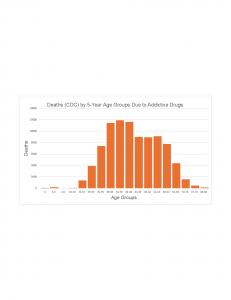
Breaking Bad Science Advisor Dr. Donna J. Nelson is Martin Luther King Fellow at Massachusetts Institute of Technology
President Trump’s Education Department Can Ask Universities to Communicate to Students Dangers of Street Drugs
NORMAN, OK, UNITED STATES, June 19, 2025 /EINPresswire.com/ -- Dr. Donna J. Nelson has been named a Martin Luther King (MLK) Fellow at Massachusetts Institute of Technology (MIT). During this appointment, Dr. Nelson will change the focus of her creative activities pertaining to illicit drugs. After being the Science Advisor for the television drama Breaking Bad, she now turns to the real-world illicit fentanyl crisis in the U.S. Dr. Nelson researches CDC final data and U.S. Border Patrol data, which she collects, correlates, graphs, and analyzes, in order to work against the fentanyl crisis in the U.S.
Fentanyl is a synthetic, potent opioid painkiller, which is safe when obtained from a medical professional, but often lethal when obtained on the street. Fentanyl is especially dangerous because it is so potent - 50 to 100 times more potent than morphine. Frequently, illicit fentanyl is laced into other drugs on the street, so the victim may be unaware of its presence or its amount. Many U.S. families unexpectedly lost beloved children who experimented with street drugs, which were laced with small amounts of illicit fentanyl. When fentanyl death rates, using CDC “final” data, numbered over 200 people per day in 2022 and 2023, the illicit fentanyl crisis received much attention in the news and from many people, including Donald Trump, who throughout the 2024 election promised to end the fentanyl crisis. However, according to CDC provisional data for 2024, the number of deaths each day is “only” about 100, so fewer people are expressing concern. This raises the question of what should constitute an acceptable number of deaths.
The age distribution of deaths due to illicit fentanyl was first bar-graphed in 2021 by Jim Rauh, founder of Families Against Fentanyl, finding that ages 18 to 45 were impacted most, which has changed little over time. Analyzing other illicit drugs commonly found on the street produces similar bar graphs. A bar graph of 2023 deaths using CDC “final” data and including more street drugs gives a similar age distribution. This similar bar graph of illicit drug poisoning deaths includes additional drugs commonly laced into street drugs, such as opioids, nitazenes, and xylazine, as well as fentanyl.
An important feature is that the ages at which the death rate begins increasing sharply are after age 24, which is also the age by which a typical student has obtained a college degree. The bar graph showing the number of deaths distributed by age reveals that the ages most impacted by this larger set of illicit drugs are 25 to 64, but a more granular analysis reveals that death rates for ages 30 to 44 are highest. This suggests that it should be most impactful to warn people about the dangers of street drugs before they reach the age of 24, such as while they attend college.
College is an optimal time to inform this age group for multiple reasons. First, this is a typical age for students in college. Second, it is convenient to reach people of this age because large numbers are collected together. Third, valuable and talented candidates for many critical professions, such as doctors, dentists, attorneys, must pass through college and are in a learning mindset. Thus, college students should be warned about the dangers of street drugs, before the age of 24, which is when the large increases in death numbers begin.
The similar age analyses across many illicit drugs simplifies finding solutions for the addictive drug problem generally is a benefit. If a solution based on age analysis is developed for fentanyl, that solution should also be viable for other addictive drugs laced into street drugs.
Because college students are typically younger than 24, colleges can warn them about fentanyl and other addictive drugs during each orientation. Each semester, universities generally have orientation programs for new students and welcoming programs for returning students. Universities could simply add the message “Avoid street drugs” to each regular orientation program at the beginning of each semester. If a university is already warning students, it can give the message more emphasis, more details, or more times. This is an opportunity to have a significant impact on a large number of valuable students easily and at little expense. Thus, students would receive multiple warnings before they reach the critical age of 24. Each orientation could give students a simple message pertinent to all illicit drugs simultaneously: “Stay away from street drugs.” Currently, few schools are doing this, so this is an easy and inexpensive opportunity for improvement.
An easy way to address this would be for the Department of Education to ask universities to communicate to students the dangers of illicit street drugs. The Department of Education is marked for shutdown, but this could be one of its last requests to universities. Hopefully universities would care sufficiently about their own students to warn them that street drugs can’t be trusted, because street drugs are not regulated, and students don’t know what is in them. Using street drugs is like playing Russian Roulette.
Such data-driven analyses spawn developing new methods and programs to mitigate wicked problems and perfect storms.
DR. DONNA J. NELSON
Dr. Donna J. Nelson
djnelson@ou.edu
Visit us on social media:
LinkedIn
Facebook
X
Other
Distribution channels: Education, Media, Advertising & PR, Movie Industry, Politics, Science
Legal Disclaimer:
EIN Presswire provides this news content "as is" without warranty of any kind. We do not accept any responsibility or liability for the accuracy, content, images, videos, licenses, completeness, legality, or reliability of the information contained in this article. If you have any complaints or copyright issues related to this article, kindly contact the author above.
Submit your press release

